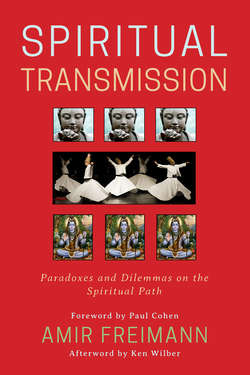Читать книгу Spiritual Transmission - Amir Freimann - Страница 9
На сайте Литреса книга снята с продажи.
ОглавлениеTHE FUNCTIONS AND CLASSIFICATIONS OF THE TEACHER-STUDENT RELATIONSHIP
There are four classifications of spiritual masters:
the ordinary spiritual master,
the bodhisattva spiritual master who has attained certain bhumis,
the Nirmanakaya spiritual master, and
the Sambhogakaya spiritual master.
These four types are related to an individual’s spiritual realizations. When one is ordinary or just beginning, one cannot attend Buddhas and bodhisattvas who have attained higher levels as spiritual masters, so one attends an ordinary spiritual master. When one’s karmic obscurations are more purified, one can attend a bodhisattva spiritual master who has attained higher levels. After one accomplishes the great accumulation path, one can attend a Nirmanakaya spiritual master. When one attains the bodhisattva’s level, one can attend a Sambhogakaya spiritual master.
–GAMPOPA, THE JEWEL ORNAMENT OF LIBERATION
The first step… is to acknowledge certain empirical facts about student-teacher relationships. (1) Almost all spiritual seekers progress through stages along the spiritual path. (2) Most practitioners study with several teachers during their lifetimes and build up different relationships with each. (3) Not every spiritual teacher has reached the same level of accomplishment. (4) The type of relationship appropriate between a specific seeker and a specific teacher depends upon the spiritual level of each. (5) People usually relate to their teachers in progressively deeper manners as they advance along the spiritual path. (6) Because the same teacher may play different roles in the spiritual life of each seeker, the most appropriate relationship each seeker has with that teacher may [change].
–ALEXANDER BERZIN, WISE TEACHER, WISE STUDENT
Before we dive into the various paradoxes and dilemmas which are the heart of this book, it is useful to become acquainted with Alexander Berzin’s classifications in Wise Teacher, Wise Student. The rationale for these classifications is provided by Gampopa Sonam Rinchen in The Jewel Ornament of Liberation as well as by Berzin. While Gampopa’s and Berzin’s classifications are specific to teacher-student relationships in the Buddhist path, they are readily applicable to other paths and traditions.
INFORMATION CONVEYANCE
This is the common type of relationship between teachers and students in schools and academic institutions, as well as in religious and spiritual contexts. Berzin describes this kind of relationship as follows: “Let us call someone who conveys information about Buddha’s teachings from a withdrawn perspective a ‘Buddhism professor.’ A person who not merely sits in the audience, but who actually studies with such a Buddhism professor would be a ‘student of Buddhism.’”
KNOWLEDGE APPLICATION
If the “information conveyance relationship” is comparable to the academic teacher-student relationship, this type is comparable to the master craftsman-apprentice relationship. Berzin refers to the “Dharma instructor,” who is someone “who imparts the teachings from the point of view of their practical application to life, based on personal experience,” and he describes the difference between the “Buddhism professor” and the “Dharma instructor” as follows:
“Buddhism professors teach information gained from texts or from Western scholarly research. In addition, they may have tried to figure out the meaning of the teachings intellectually and thus may also teach from intellectual insight and understanding. Dharma instructors also have some level of scriptural knowledge and teach accordingly. In addition, however, they explain from experiential insight and understanding, gained from putting the teachings into practice and from trying to apply them to life. Buddhism professors may also have experiential insight, but they do not usually convey these insights to others.”
SPIRITUAL MENTORSHIP
Berzin further describes a spiritual mentor as “someone who leads others along the graded path to enlightenment,” and he distinguishes this relationship from the former two as follows:
“The Buddhist teachings differentiate between insights and realizations. An insight does not make a significant change in one’s life, but may lead in that direction. A realization, on the other hand, whether it be partial or complete, actually produces a noticeable improvement that lasts. The distinction we are drawing here between Dharma instructors and spiritual mentors derives from this difference. Dharma instructors may have either insight or realization, whereas spiritual mentors need to have some level of realization…
“Buddhism professors and Dharma instructors teach primarily through verbal instruction. For spiritual teachers to guide seekers fully, however, they need also to embody the teachings integrated into their personalities. Only then, as spiritual mentors, can they truly inspire and teach disciples by their living examples. Because of the obvious personal development of mentors, spiritual seekers feel confident in entrusting themselves as disciples to them, to help reach similar levels of self-transformation. Spiritual mentors, then, help disciples to develop their personalities.”
ROOT GURU-DISCIPLE RELATIONSHIP
According to Berzin, “Root gurus are the spiritual mentors who turn disciples’ hearts and minds most ardently to the Buddhist path. They are the strongest sources of inspiration to sustain disciples throughout their spiritual journeys. The relationships with such teachers act as roots for all attainments.”
